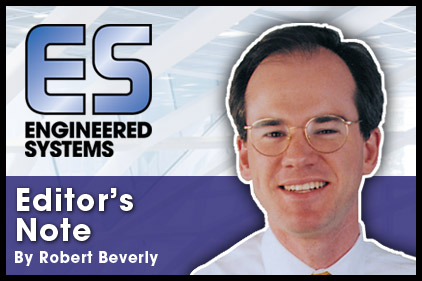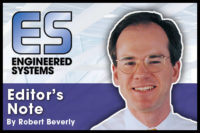But the start of a new year is the best time to make some time for that kind of examination, isn’t it? The holidays are behind us, the calendar is replaced, and with all 12 of those pages in front of us, why not take a fresh look at some thorny issues or nagging inefficiencies? I’m not talking about reinventing the wheel, but perhaps some wheel designs or manufacturing procedures could use a little tweaking for a smoother, faster ride.
This theme emerges throughout our issue this month. Howie McKew finally gets a feature platform to lay out his case for third-party commissioning and third-party TAB and their proper roles in the project process. Ghosts of his columns past also pop up upon reading this month’s “Building Automation” column by Paul Ehrlich and Ira Goldschmidt — you’ve seen the idea of investing more in full-time BAS expertise in these pages before — but this column breaks down what types of knowledge might be worth the effort.
This nudging toward next-level performance (it might read a little more like a push sometimes)(OK, perhaps every now and then it resembles something closer to a shove) also appears in Kevin Dickens’ article about IAQ and design parameters for data centers. This is an area where factors like association standards and type of data center client can complicate an already complex assignment. In the pursuit of smart performance, the last thing to add to that mix is adherence to outdated guidance when it isn’t needed.
Even our BIM-related feature looks at a firm who is now embracing the technology not only as a design tool but an entirely different business opportunity.
I don’t usually spend much of this space rehashing the issue’s contents, but my point is: The definitions of some of the most basic processes and organizations in this industry remain open to revision and improvement — if people dare to ask the right questions and imagine possible solutions. I’m proud that ES can help a few of those people reach a broader audience.
Speaking of our readership, I had a recent e-mail exchange with a reader who mentioned that he enjoyed the magazine, and that he agreed with some parts of it, but put other parts of it to the side. I got the sense he might’ve been tempted to feel bad about telling me that, but in my opinion, that’s exactly the idea. We can’t pretend all of this will be useful to you, or that you’ll agree with all of it. In some cases — e.g., the proper approach for facility BAS personnel — we have intentionally provided contradictory opinions.
We’re not here to necessarily tell you The Way To Do It on all subjects. We do want to show you how some ideas have worked (or not worked) for others, complemented by some knowledgeable, insightful opinions. Get one decent idea per issue that applies to your own professional situation, for use either now or down the road, and we’re happy.
ENGINEERING AT THE PALACE
Beyond these pages, we are also glad to be a sponsor for the 2012 Global Engineering Conference, presented by Carrier. Taking place at Caesar’s Palace in Las Vegas, the event combines keynotes, workshops, and other opportunities to “rethink, restore, and regenerate,” as Carrier president Geraud Darnis puts it. Even if it didn’t tie into this page’s whole top-of-the-year theme, it’s still a good way to put it.
DRIVING FUTURE COVERAGE
Back to where we started: in his own casual conversations, Steve Liescheidt got a huge variety of feedback about what exactly needed to be addressed in the world of motors and drives working in harmony. What areas do you think need the most attention and discussion? By the time you get this print issue, we’ll have a new survey question or blog entry up at the website to get your feedback on this. Take two clicks and let us know. ES





